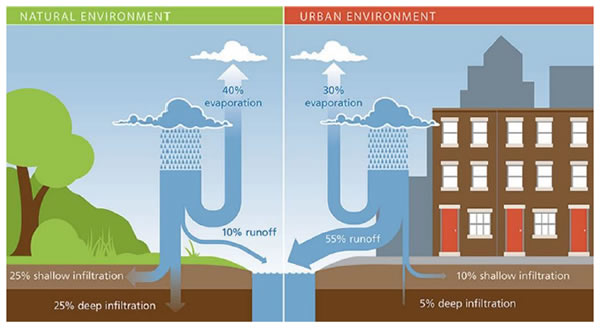Flow Duration Curves: A New Model to Envision Healthy Watersheds and Resilient Communities
February 2021
The traditional urban design includes many impervious surfaces. As cities and towns continue to grow, natural landscapes get replaced by buildings, houses, roads, and parking lots. These hard surfaces block water from soaking into the ground, leaving the water with fewer places to go, which can create problems for surrounding communities if not properly managed. In an undeveloped landscape, rain is able to soak into the ground. Any contaminants that the rain might have come into contact with on the surface is readily filtered out as it flows through layers of soil before finally entering the groundwater. This natural process of infiltration and slow release of groundwater allows watersheds increased resilience against storms and flooding. However, this resilient effect is damaged when landscapes are paved over with impervious material that water cannot flow through. In these instances, rainfall collects and flows, leading to a high volume of stormwater runoff that rushes down streets, pools in parking lots, and empties into nearby rivers and streams without being afforded the filtering effect of the soil. This can result in urban flooding, erosion, and the pollution of nearby waterways as contaminated stormwater easily enters nearby habitats.

Floods are one of the most common natural disasters in the United States: costing communities millions of dollars in clean up and repairs, displacing residents, and sometimes resulting in adverse health effects from pathogens carried in flood waters. The frequency of severe flooding events has increased in the last three decades and is expected to continue as climate change brings wetter and more severe storms. In response to flooding (among other issues caused by impervious surfaces) many communities have relied on stormwater management practices to minimize the impacts of storms on their respective watersheds. However, current stormwater management standards do not fully address the problems at hand. Correcting the impact of development on watersheds requires a holistic watershed management approach.
The dilemma for many communities is how to meet the demands of a growing population and the need for future development while preserving a healthy watershed and enhancing its resilience. A new SNEP- funded project intends to provide local decision-makers with recommendations on immediate and future actions required to maintain natural hydrologic resiliency. The project aims to help communities adopt conservation development practices and holistic hydrologic management approaches that will make them more resilient to future climate conditions, while also accommodating future development.
What is a Flow Duration Curve? It describes the flow characteristics (frequency and duration) of a stream over a long period of time. Flow Duration Curves can be used to quantify impacts of development on a watershed as well as benefits of adopting alternative development practices.
The first phase of the project involves the development of Flow Duration Curves (FDCs) (see box); whereas phase two involves the creation of recommendations for better management practices based on the results of compared modeled scenarios. By comparing stream flows between pre- development, current, and future development scenarios, FDCs allow for powerful diagnostic evaluation of the impacts of watershed development and the potential benefits of future management alternatives – some of which can include the implementation of green infrastructure. FDCs will be created using existing calibrated hydrologic and watershed management models for the Taunton River watershed. With the input of a committee of experts, the FDC model will serve to create recommendations for municipalities and local decision- makers to adopt sustainable development practices that conserve healthy hydrological conditions by incorporating green infrastructure, low impact development, and landscape architecture.

This is a two-year project currently in the modeling phase. In addition to the modeled impacts and expert recommendations, the project will also deliver educational materials to municipal staff, city planners, watershed advocates, and other local decision-makers in the SNEP region on how to implement these recommendations. We can expect these results next year, so stay tuned and help us envision resilient communities and healthy watersheds.
For more information, please contact Ray Cody ([email protected]).
1. Holistic Watershed Management for Existing and Future Land Use Development Activities: Opportunities for Action for Local Decision Makers. SNEP
2. Flinker, Peter (2010). The Need to Reduce Impervious Cover to Prevent Flooding and Protect Water Quality. Rhode Island Department of Environmental Management. https://reduceflooding.com/wp-content/uploads/2020/12/impervious-cover.pdf (8.1 MB)
3. Denchak, Melissa (2019). Flooding and Climate Change: Everything You Need to Know. NRDC. https://www.nrdc.org/stories/flooding-and-climate-change- everything-you-need-know#causes
